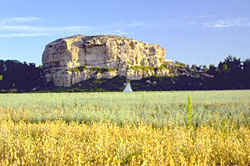Places: Pompey's Pillar, Montana
One of the perks of being a member of Lewis and Clark's Corps of Discovery was having a landmark named in one's honor. Mountains, valleys, rivers and geologic formations were named for the men of the Corps, their commanders, dignitaries, and even a few girlfriends back home. Sacajawea was honored with Bird Woman's River, now Sacajawea River, in Ferguson County, Montana. Her small son, Jean-Baptiste Charbonneau, was also honored with a sandstone pillar near what is now Billings Montana, Pompey's Pillar.
During their journey to the Pacific Coast, the Corps of Discovery split, trying to find the source of the Missouri River and a navigable waterway that would take them closer to the Rocky Mountains and the home range of the Shoshone people. Lewis traveled along what is now the Marias River, named for his fiancée at the time. William Clark took along Sacajawea and her baby. The group traveled up the Yellowstone River, finding a large round formation of sandstone about 150 feet high. Clark was found of Sacajawea, whom he'd nicknamed Janey, and he had a soft spot for her son, Jean-Baptiste, whom he'd nicknamed Pomp or Pompey. Clark called the rock formation Pompey's Tower, hiked to the top of the rock, and inscribed his name and the date, July 25, 1806, into its surface.
The name was later changed to Pompey's Pillar. In addition to Clark's autograph, one of the few tangible evidences of the expedition, there are Native petroglyphs and doodles from other travelers who happened nearby. The rock was designated a National Monument in 2001. Fittingly for a tribute to a months-old baby, it is one of the smallest National Monuments in land area, only 51 acres.
During their journey to the Pacific Coast, the Corps of Discovery split, trying to find the source of the Missouri River and a navigable waterway that would take them closer to the Rocky Mountains and the home range of the Shoshone people. Lewis traveled along what is now the Marias River, named for his fiancée at the time. William Clark took along Sacajawea and her baby. The group traveled up the Yellowstone River, finding a large round formation of sandstone about 150 feet high. Clark was found of Sacajawea, whom he'd nicknamed Janey, and he had a soft spot for her son, Jean-Baptiste, whom he'd nicknamed Pomp or Pompey. Clark called the rock formation Pompey's Tower, hiked to the top of the rock, and inscribed his name and the date, July 25, 1806, into its surface.
The name was later changed to Pompey's Pillar. In addition to Clark's autograph, one of the few tangible evidences of the expedition, there are Native petroglyphs and doodles from other travelers who happened nearby. The rock was designated a National Monument in 2001. Fittingly for a tribute to a months-old baby, it is one of the smallest National Monuments in land area, only 51 acres.




Comments
Post a Comment